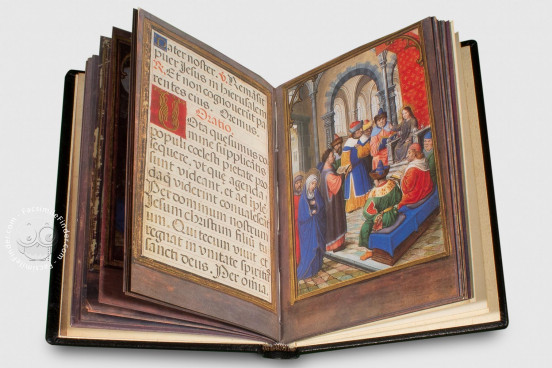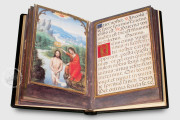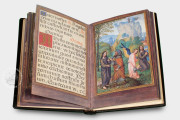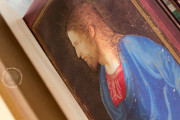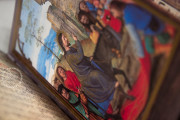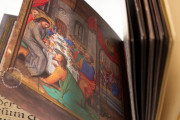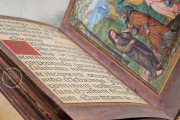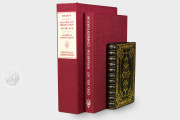Made in the twilight of the art of manuscript illumination, the Beatty Rosarium is a crowning monument to end the reign of the hand-written and decorated book in Western Europe. Each of its thirty-three full-page miniatures in vivid colors appears opposite a prayer to the Virgin. A dedicatory preface in Spanish, added not long after the completion of the bulk of the manuscript, opens the intimate codex.
Following a prayer to God and All Saints, the Latin text is a rosarium, an assemblage of thirty-one devotions to the Virgin Mary. The textual genre refers to a garden or garland of roses, embodying the anthology of brief prayers.
Miniatures for Meditation
The collection of glorious images illustrates the life of the Virgin and the Passion of Christ. Except for a single miniature added later, the renowned Simon Bening probably executed each of these himself as one of his final surviving masterpieces. While his miniatures in other manuscripts often feature elaborate fictive architectural frames or the famed trompe l’oeil Ghent-Bruges borders strewn with flowers, simple painted wooden frames surround the images in the Beatty Rosarium. This arrangement facilitated meditation on the proximate prayer and its corresponding image and was thus well-suited to personal devotion.
Since each miniature could be enjoyed as an independent panel painting with its faux wooden frame, a later owner lamentably gave in to the temptation to enjoy the images as such: the manuscript was cut up in the modern era into separate leaves, suffering the unfortunate fate of many an illuminated manuscript.
A Royal Prayerbook
The original owner was someone residing on the Iberian Peninsula. One unique and significant feature is that the margins are painted in a regal purple, which is likely original. The script is also a large and elegant Gothic Rotunda typically found in other sixteenth-century manuscripts created for Spanish patrons.
After the book changed owners early in its history, the leaves added to the beginning and the end of the book were written on purple-dyed parchment, complemented by an inscription in Spanish recording that the manuscript was once owned by King Philip II of Spain (1527-1598). Also added at that time were a miniature of Christ and a prayer in an Antigua script (Humanistic Minuscule). Although the binding is perhaps not original, it is a wonderful example of sixteenth-century Spanish bookbinding and features elaborate gilt tooling.
Illustrious Owners through the Centuries
One seventeenth-century owner was Corfitz Ulfeldt (1606-1664), a prominent official who served at the court of King Christian IV of Denmark. An inscription commemorates his presentation of the book as a gift to Carl Gustav Wrangel (1613-1676), whose daughter's marriage to Ernst Ludwig von Putbus (1649-1702) is recorded in the book. The manuscript was thence handed down in the Putbus family until it ultimately came into the hands of the Irish American bibliophile A. Chester Beatty (1875-1968). Beatty bequeathed his substantial collection to the Irish nation, which is now housed in Dublin Castle.
We have 1 facsimile edition of the manuscript "Beatty Rosarium": Das Rosarium facsimile edition, published by Akademische Druck- u. Verlagsanstalt (ADEVA), 1985
Request Info / Price
